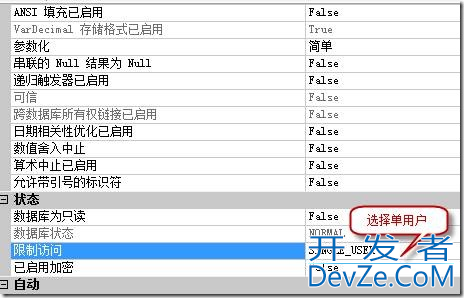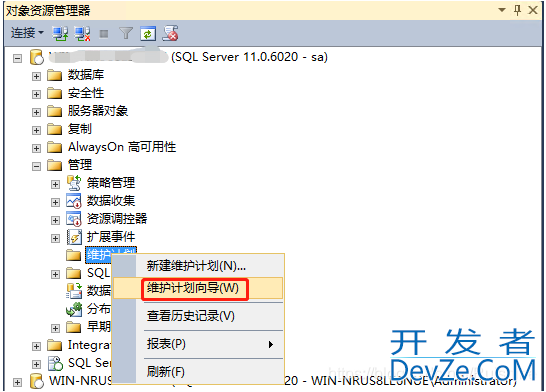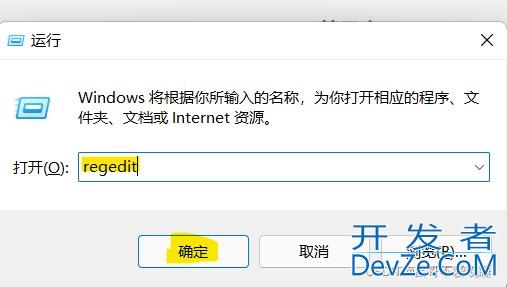SQLite教程(十三):C语言编程实例代码(1)
一、获取表的Schema信息:
1). 动态创建表。
2). 根据sqlite3提供的API,获取表字段的信息,如字段数量以及每个字段的类型。
3). 删除该表。
见以下代码及关键性注释:
复制代码 代码如下: #include <sqlite3.h> #include <string>using namespace std;
void doTest()
{ sqlite3* conn = NULL; //1. 打开数据库 int result = sqlite3_open("D:/mytest.db",&conn); if (result != SQLITE_OK) { sqlite3_close(conn); return; } const char* createTableSQL = "CREATE TABLE TESTTABLE (int_col INT, float_col REAL, string_col TEXT)"; sqlite3_stmt* stmt = NULL; int len = strlen(createTableSQL); //2. 准备创建数据表,如果创建失败,需要用sqlite3_finalize释放sqlite3_stmt对象,以防止内存泄露。 if (sqlite3_prepare_v2(conn,createTableSQL,len,&stmt,NULL) != SQLITE_OK) { if (stmt) sqlite3_finalize(stmt); sqlite3_close(conn); return; } //3. 通过sqlite3_step命令执行创建表的语句。对于DDL和DML语句而言,sqlite3_step执行正确的返回值 //只有SQLITE_DONE,对于SELECT查询而言,如果有数据返回SQLITE_ROW,当到达结果集末尾时则返回 //SQLITE_DONE。 if (sqlite3_step(stmt) != SQLITE_DONE) { sqlite3_finalize(stmt); sqlite3_close(conn); return; } //4. 释放创建表语句对象的资源。 sqlite3_finalize(stmt); printf("Succeed to create test table now.\n"); //5. 构造查询表数据的sqlite3_stmt对象。 const char* selectSQL = "SELECT * FROM TESTTABLE WHERE 1 = 0"; sqlite3_stmt* stmt2 = NULL; if (sqlite3_prepare_v2(conn,selectSQL,strlen(selectSQL),&stmt2,NULL) != SQLITE_OK) { if (stmt2) sqlite3_finalize(stmt2); sqlite3_close(conn); return; } //6. 根据select语句的对象,获取结果集中的字段数量。 int fieldCount = sqlite3_column_count(stmt2); printf("The column count is %d.\n",fieldCount); //7. 遍历结果集中每个字段meta信息,并获取其声明时的类型。 for (int i = 0; i < fieldCount; ++i) { //由于此时Table中并不存在数据,再有就是SQLite中的数据类型本身是动态的,所以在没有数据时 //无法通过sqlite3_column_type函数获取,此时sqlite3_column_type只会返回SQLITE_NULL, 开发者_Spark //直到有数据时才能返回具体的类型,因此这里使用了sqlite3_column_decltype函数来获取表声 //明时给出的声明类型。 string stype = sqlite3_column_decltype(stmt2,i); stype = strlwr((char*)stype.c_str()); //下面的解析规则见该系列的“数据类型-->1. 决定字段亲缘性的规则”部分,其链接如下: ////www.jb51.net/article/65424.htm if (stype.find("int") != string::npos) { printf("The type of %dth column is INTEGER.\n",i); } else if (stype.find("char") != string::npos || stype.find("text") != string::nposhttp://www.devze.com) { printf("The type of %dth column is TEXT.\n",i); } else if (stype.find("real") != string::npos || stype.find("floa") != string::npos || stype.find("doubwww.devze.com") != string::npos ) { printf("The type of %dth column is DOUBLE.\n",i); } } sqlite3_finalize(stmt2); //8. 为了方便下一次测试运行,我们这里需要删除该函数创建的数据表,否则在下次运行时将无法 //创建该表,因为它已经存在。 const char* dropSQL = "DROP TABLE TESTTABLE"; sqlite3_stmt* stmt3 = NULL; if (sqlite3_prepare_v2(conn,dropSQL,strlen(dropSQL),&stmt3,NULL) != SQLITE_OK) { if (stmt3) sqlite3_finalize(stmt3); sqlite3_close(conn); return; } if (sqlite3_step(stmt3) == SQLITE_DONE) { printf("The test table has been dropped.\n"); } sqlite3_finalize(stmt3); sqlite3_close(conn); }int main()
{ doTest(); return 0; } //输出结果为: //Succeed to create test table now. //The column count is 3. //The type of 0th column is INTEGER. //The type of 1th column is DOUBLE. //The type of 2th column is TEXT. //The test table has been dropped.二、常规数据插入:
1). 创建测试数据表。
2). 通过INSERT语句插入测试数据。 3). 删除测试表。 见以下代码及关键性注释:复制代码 代码如下:
#include <sqlite3.h> #include <string> #include <stdio.h>using namespace std;
void doTest()
{ sqlite3* conn = NULL; //1. 打开数据库 int result = sqlite3_open("D:/mytest.db",&conn); if (result != SQLITE_OK) { sqlite3_close(conn); return; } coVXCKYvexRnst char* createTableSQL = "CREATE TABLE TESTTABLE (int_col INT, float_col REAL, string_col TEXT)"; sqlite3_stmt* stmt = NULL; int len = strlen(createTableSQL); &nbsVXCKYvexRp; //2. 准备创建数据表,如果创建失败,需要用sqlite3_finalize释放sqlite3_stmt对象,以防止内存泄露。 if (sqlite3_prepare_v2(conn,createTableSQL,len,&stmt,NULL) != SQLITE_OK) { if (stmt) sqlite3_finalize(stmt); sqlite3_close(conn); return; } //3. 通过sqlite3_step命令执行创建表的语句。对于DDL和DML语句而言,sqlite3_step执行正确的返回值 //只有SQLITE_DONE,对于SELECT查询而言,如果有数据返回SQLITE_ROW,当到达结果集末尾时则返回 //SQLITE_DONE。 if (sqlite3_step(stmt) != SQLITE_DONE) { sqlite3_finalize(stmt); sqlite3_close(conn); return; } //4. 释放创建表语句对象的资源。 sqlite3_finalize(stmt); printf("Succeed to create test table now.\n");int insertCount = 10;
//5. 构建插入数据的sqlite3_stmt对象。 const char* insertSQL = "INSERT INTO TESTTABLE VALUES(%d,%f,'%s')"; const char* testString = "this is a test."; char sql[1024]; sqlite3_stmt* stmt2 = NULL; for (int i = 0; i < insertCount; ++i) { sprintf(sql,insertSQL,i,i * 1.0,testString); if (sqlite3_prepare_v2(conn,sql,strlen(sql),&stmt2,NULL) != SQLITE_OK) { if (stmt2) sqlite3_finalize(stmt2); sqlite3_close(conn); return; } if (sqlite3_step(stmt2) != SQLITE_DONE) { sqlite3_finalize(stmt2); sqlite3_close(conn); return; } printf("Insert Succeed.\n"); } sqlite3_finalize(stmt2); //6. 为了方便下一次测试运行,我们这里需要删除该函数创建的数据表,否则在下次运行时将无法 //创建该表,因为它已经存在。 const char* dropSQL = "DROP TABLE TESTTABLE"; sqlite3_stmt* stmt3 = NULL; if (sqlite3_prepare_v2(conn,dropSQL,strlen(dropSQL),&stVXCKYvexRmt3,NULL) != SQLITE_OK) { if (stmt3) sqlite3_finalize(stmt3); sqlite3_close(conn); return; } if (sqlite3_step(stmt3) == SQLITE_DONE) { printf("The test table has been dropped.\n"); } sqlite3_finalize(stmt3); sqlite3_close(conn); }int main()
{ doTest(); return 0; } //输出结果如下: //Succeed to create test table now. //Insert Succeed. //Insert Succeed. //Insert Succeed. //Insert Succeed. //Insert Succeed. //Insert Succeed. //Insert Succeed. //Insert Succeed. //Insert Succeed. //Insert Succeed. //The test table has been dropped.







 加载中,请稍侯......
加载中,请稍侯......
精彩评论